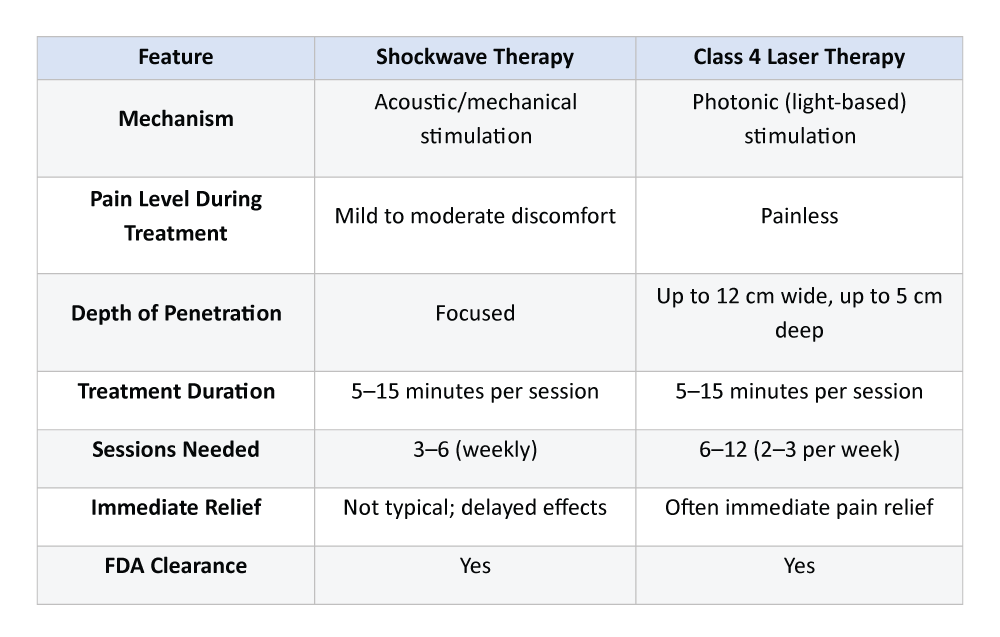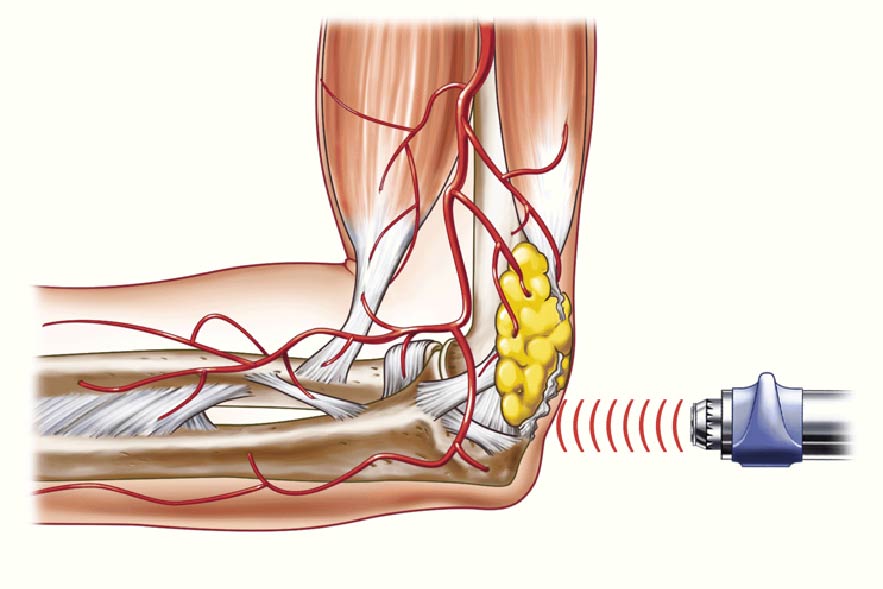Shockwave Therapy vs. Class 4 Laser Therapy: Which is Better?
Chronic pain, soft tissue injuries, and musculoskeletal issues are among the most common complaints in clinical practice. In recent years, non-invasive therapeutic options have become increasingly popular—particularly Shockwave Therapy (SWT) and Class 4 Laser Therapy (C4LT). Both treatments aim to promote healing and reduce pain, but their mechanisms, indications, and effectiveness differ in notable ways.
So, which therapy is better? The answer depends on the specific condition, patient profile, and therapeutic goals. This blog compares Shockwave Therapy and Class 4 Laser Therapy to help patients and clinicians make more informed decisions.
What is Shockwave Therapy?
Shockwave Therapy, or Extracorporeal Shock Wave Therapy (ESWT), uses high-energy acoustic waves to stimulate healing in injured tissues. Originally developed for breaking up kidney stones (lithotripsy), it is now widely used in orthopedics and sports medicine.
How it works:
- Delivers focused mechanical energy to injured tissue
- Increases blood flow and metabolism
- Breaks down calcifications and scar tissue
- Stimulates collagen production and tissue regeneration
- Reduces pain through hyperstimulation analgesia
Common Applications:
- Plantar fasciitis
- Tennis elbow
- Calcific tendonitis
- Achilles tendinopathy
- Trigger points and myofascial pain
What is Class 4 Laser Therapy?
Class 4 Laser Therapy uses high-powered infrared light to penetrate deep into tissues and stimulate cellular function. It’s a form of photobiomodulation—using specific wavelengths of light to trigger biological responses.
How it works:
- Penetrates 3–5 cm deep into tissue
- Enhances mitochondrial activity and ATP production
- Reduces inflammation and oxidative stress
- Promotes angiogenesis and tissue repair
- Provides rapid pain relief via neurochemical modulation
Common Applications:
- Soft tissue injuries
- Arthritis
- Neuropathy
- Back and neck pain
- Post-surgical recovery
Key Differences: Shockwave vs. Class 4 Laser

Advantages of Shockwave Therapy
- Effective for Chronic Tendinopathies: SWT is well-supported for conditions like plantar fasciitis and calcific tendonitis where degenerative changes need targeted mechanical stimulation.
- Long-Term Results: Patients often experience sustained improvement months after treatment ends.
- Minimal Sessions Required: Usually only a few sessions are necessary to see results.
- Breaks Down Calcifications: One of the few non-invasive treatments that can address calcium deposits in soft tissues.
Disadvantages
- Can be uncomfortable during application.
- Not ideal for acute inflammation.
- Contraindicated in certain conditions (e.g., bleeding disorders, tumors).
Advantages of Class 4 Laser Therapy
- Non-Invasive and Painless: Offers pain relief without discomfort, making it ideal for sensitive patients.
- Rapid Anti-inflammatory Effect: Effective for acute injuries and post-surgical swelling.
- Accelerated Healing: Stimulates cellular regeneration at the mitochondrial level.
- Safe for a Broad Range of Conditions: Useful for both chronic and acute issues, from back pain to nerve injuries.
Disadvantages
- Requires more frequent treatments.
- Results can vary based on skin type and depth of injury.
- High-quality equipment and proper training are essential for effective use.
Clinical Evidence & Research
Studies on both modalities show positive outcomes, but the evidence varies by condition.
Shockwave Therapy: Numerous randomized controlled trials (RCTs) support its use in calcific shoulder tendinopathy, plantar fasciitis, and chronic Achilles tendinopathy. A 2017 meta-analysis in American Journal of Sports Medicine showed significant long-term improvement in pain and function.
Class 4 Laser Therapy: Evidence supports its use in treating acute soft tissue injuries, neuropathic pain, and post-operative recovery. A 2020 review in Photomedicine and Laser Surgery noted promising outcomes for musculoskeletal disorders, though called for more high-quality RCTs.
Which Is Better?
- You have a chronic, degenerative tendon issue.
- You need to break down scar tissue or calcifications.
- You’re looking for long-term improvement with fewer sessions.
- You’re okay with some discomfort during treatment.
- You have acute inflammation or soft tissue injury.
- You prefer a painless treatment.
- You’re managing nerve-related pain or post-surgical recovery.
- You want faster relief with cumulative effects.
Combination Therapy: The Best of Both Worlds?
Interestingly, many clinics now offer both modalities—sometimes in the same treatment plan. Using shockwave to stimulate repair and laser to accelerate healing and reduce inflammation can produce synergistic effects.
A 2023 case series in Clinical Rehabilitation showed improved outcomes in chronic plantar fasciitis when both therapies were combined compared to either alone.
Conclusion
Both Shockwave Therapy and Class 4 Laser Therapy are powerful, non-invasive tools for treating pain and injury. There is no one-size-fits-all answer to which is better—each therapy has its own strengths. Shockwave Therapy excels in treating chronic tendon issues and promoting structural healing. Class 4 Laser Therapy is best for reducing inflammation, managing pain, and supporting cellular repair. If you’re unsure which treatment is right for you, consult a chiropractor or physiotherapist at Encompass Sports Therapy.


